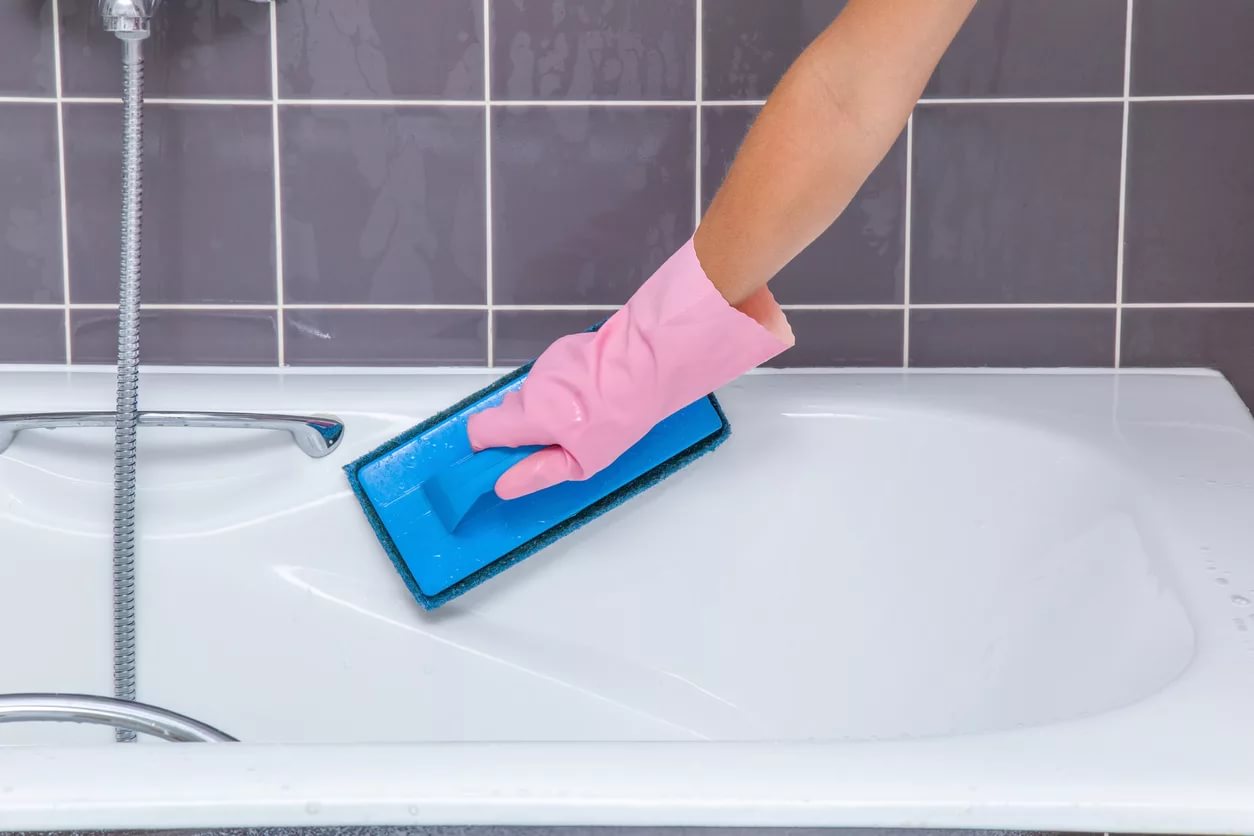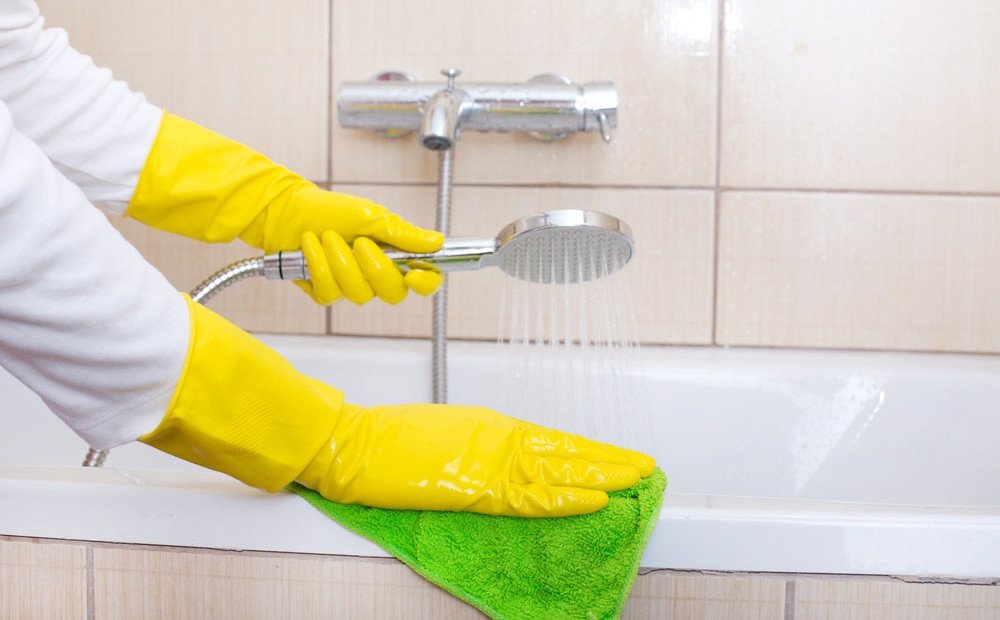Methods for removing limescale in the bathroom
Unfortunately, limescale appears to a greater or lesser extent in every bathroom. But if you do not take any action, the problem is getting worse every day and then it will be simply impossible to remove the lime. What is the best remedy for limescale? Can the problem be solved without chemicals?

Causes of the appearance of limescale
With constant contact of the surface with liquid, water stone or limescale forms. This happens on any surface, but since plumbing fixtures are used constantly in the bathroom, the intensity of pollution is much higher here than, for example, in the kitchen.

This plaque appears due to the composition of the water. For example, excess magnesium and calcium salts lead to more serious contamination. And if the water has a high iron content, then this will cause the enamel to turn yellow.
Also, more serious pollution in the bathroom is due to the combination of water and soap. Due to the soapy component, the plaque is compacted, and over time it completely turns into solid stone deposits. It is simply impossible to remove such formations with water.
How to understand that limescale has appeared:
- There are gray and yellowish streaks on the surfaces;
- Contamination is not simply removed by water;
- The surface becomes rough to the touch.
We remove plaque with improvised means
Soda, vinegar, whiteness and dishwashing detergent are found in every home. And each of these formulations will provide you with invaluable service in the fight against limescale. The advantages of such funds are low cost and availability. But the disadvantage is that their illiterate use will hopelessly ruin your bath.

Soda and vinegar
When baking soda and vinegar are mixed, a chemical reaction takes place, resulting in the release of carbon dioxide, salt and water. Baking soda and vinegar are used to clean enameled surfaces both individually and in tandem. In the latter case, cleaning is more efficient.

Procedure:
- The surface of the bath is rinsed with water.
- They are treated with soda. It is best to do this with gentle movements, without excessive pressure, since abrasive particles, even small ones, can damage the enamel structure. Soda gruel is left on the walls of the bath for 2-3 hours.
- Vinegar is sprayed over a layer of baking soda. The amount of vinegar essence must be sufficient for a chemical reaction to start over the entire area of the bath. If cleaning occurs only "in places", after rinsing, these islands will be noticeable.
- When the reaction of soda and vinegar is over, the mass is rubbed over the entire surface of the bath, the plaque softens and then is easily washed off with water.
A more active agent is a mixture of baking soda and soda ash with vinegar. Such a composition will be more aggressive and, if used carelessly, can corrode the enamel.Therefore, after mixing two types of soda in equal amounts and applying the mixture to the walls of the bath, spray the vinegar after 30-40 minutes.

Dishwashing liquid
This very gentle remedy is applicable only in cases where plaque has just appeared. The composition is applied with a sponge to pre-moistened surfaces. To start the cleansing process, the product is left for half an hour, and then washed off with water.

To increase efficiency, the walls of the bath can be pre-steamed by rinsing them with hot water.
Lemon acid
It is truly a versatile product, as it can be used on a variety of surfaces, even acrylic. True, in the case of processing acrylic, do not expect quick results, you will have to clean it several times.
Before you start cleaning, stock up on the right amount of citric acid. It usually takes three bags to process a bath.

Algorithm of actions:
- We dilute a package of citric acid in two glasses of water. The grains should dissolve completely.
- The resulting composition is applied to the walls of the bath.
- Reapply after 20 minutes. Do not wash off the first layer. And after the first and after the second application, carefully rub with a sponge.
- If we notice that the stains still remain (this is possible only in the case of old dirt), then the procedure is repeated.
- Wash off the lemon mixture with cool water.
To clean an acrylic bath, proceed as follows:
- Before using citric acid, fill the bath (sink) with water as much as possible.
- Pour the contents of the package into the bath and leave for 12 hours.
- We drain the water, rinse the walls with water.

White
It is one of the most aggressive formulations and should be used with extreme caution. The agent is used exclusively for cast iron baths with an enamel coating. It is better to dilute the product with water before use.

To make the treatment more effective, add the following products: 1 tablespoon of whiteness, 2 tablespoons of vinegar, washing powder in any amount. After that, add a little water to the mixture to make a gruel. The resulting composition is applied to heavily soiled areas with a rubber spatula. In no case take metal tools, as you risk damaging the enamel on the surface of the bath. The composition is left for 15 minutes, and then wiped off with a hard sponge.

Ammonia
And this tool is not used on its own, it must be mixed with water in equal proportions. First, the resulting mixture is treated with limescale stains, and then, to enhance the effect, the places of special pollution are covered with napkins soaked in an aqueous solution of alcohol. The exposure time depends on the degree of contamination, usually 30-60 minutes. Then the surface is treated with a sponge. Do not forget that ammonia has an unpleasant pungent odor, so it is best to use it in a well-ventilated area.

Vinegar
Vinegar is ideal for removing limescale deposits from chrome surfaces. Mix the vinegar essence with water in equal proportions, moisten a soft cloth in the resulting composition and cover the contaminated area.If the chrome elements are removed, they can be immersed in a mixture of vinegar and water for about 30 minutes.

After the procedure, the rest of the mixture is thoroughly washed off with cool water.
Hydrogen peroxide and soda
Soda and peroxide are mixed in a 1: 2 ratio (less soda than peroxide), and the result is a viscous substance. It is applied to contaminated areas, left for about an hour and then washed off.

Special means
If the plaque is old, or the composition of the water is such that a new lime layer is constantly forming on the surface of the bathtub and sink, it is better to give preference to special chemical compositions. Here are just a few of the most effective ones.
- LOC is the beloved Amway product. The main active ingredient is citric acid. It is used for cleaning bathtubs made of different materials, it is highly efficient.
- Cillit Bang. This product contains oxalic acid. Since it acts very aggressively, the preparation is not recommended for processing stone, brass, copper and galvanized products.
- Ecover is another drug whose main active ingredient is citric acid. It is used to clean any plumbing fixtures. Even on dark tiles, it does not leave streaks.
- Akrylan. If you need to remove limescale from ceramics, acrylics, enameled surfaces, then this composition will provide an invaluable service.
- Comet spray will perfectly cope with plaque on enameled surfaces, but, alas, it will not work for stone.
Care should be taken to use funds that contain the following substances:
- Acids. They are not recommended for cleaning chrome-plated surfaces. Abrasive particles are also detrimental to mixers.
- If the composition contains inorganic acids, then such funds are "contraindicated" for acrylic surfaces.
- Compositions with oxalic acid are recommended to be used as rarely as possible and only to remove old stains.
- Use chlorine-containing formulations with caution.

And one more important tip: under no circumstances use metal brushes to clean bathtubs and other plumbing fixtures.
Prevention of the appearance of limescale
As doctors say, the disease is easier to prevent than to cure later. The same is true for limescale: it is easier to minimize the risk of its appearance than to waste time, effort and money to get rid of it later.

As limescale builds up when the water dries out, make it a rule to dry the tub, tiles and mixer every time you shower. If this process is too laborious for you, and there is not enough time for it, then choose the right product to prevent the appearance of old lime stains.

As a preventive measure, you can regularly treat the bath with a glass cleaner, which contains ammonia. Apply the product to the bath, wait 20 minutes, and then rinse. Such cleaning does not need to be done every day, it is enough once a week, or 3-5 days, depending on how intensively the bathroom is used, as well as on the composition of the water.

A clean bathroom is not only beautiful. It is also a guarantee of your health and the health of your loved ones.As you can see, there are plenty of ways to get rid of limescale on a bathtub, tile or mixer. The main thing is not to leave the solution to the problem for later. The sooner you start cleaning, the more likely you will be able to get by with less aggressive formulations.
Video: how easy it is to remove limescale













